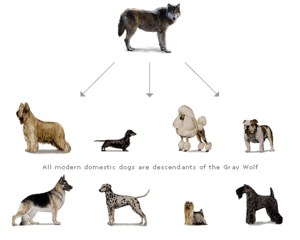Evolution of Dog Breeds: Difference between revisions
No edit summary |
No edit summary |
||
| Line 1: | Line 1: | ||
==Introduction== | ==Introduction== | ||
The evolution of dog breeds is an interesting story of human involvement in the domestication of a wild animal. The domestic dog is called <i>Canis familiaris </i> The artificial selection of dog breeds has led to diversity in size, conformation, and pelage seen today in domestic canines<ref>[https://academic.oup.com/jhered/article/90/1/71/2187103 C Vilá et. al."Phylogenetic relationships, evolution, and genetic diversity of the domestic dog." 1999.]</ref>. The dog evolved approximately 12,000 years ago when early humans domesticated animals and plants for farming during the Stone Age<ref>[https://www.jstor.org/stable/29775234?seq=3#metadata_info_tab_contents D. Morey. "The Early Evolution of the Domestic Dog." 1994.]</ref> | The evolution of dog breeds is an interesting story of human involvement in the domestication of a wild animal. The domestic dog is called <i>Canis familiaris </i> The artificial selection of dog breeds has led to diversity in size, conformation, and pelage seen today in domestic canines<ref>[https://academic.oup.com/jhered/article/90/1/71/2187103 C Vilá et. al."Phylogenetic relationships, evolution, and genetic diversity of the domestic dog." 1999.]</ref>. The dog evolved approximately 12,000-15,000 years ago when early humans domesticated animals and plants for farming during the Stone Age. There are different views on how dogs evolved- was their evolution due to humans selecting animals for domestication, or that the animals had to evolve because they were in a new ecological niche (co-existing with humans in a domestic setting) <ref>[https://www.jstor.org/stable/29775234?seq=3#metadata_info_tab_contents D. Morey. "The Early Evolution of the Domestic Dog." 1994.]</ref>? Through phylogenetic analysis of dog and gray wolf mitochondrial DNA (mtDNA) sequences, it was found that domestic dog sequences are found in at least four distinct clades, implying a single origination event and at least three other origination or interbreeding events <ref>[https://genome.cshlp.org/content/15/12/1706.full.html Ostrander et. al. "The Canine Genome." 2005.]</ref>. | ||
<ref>[https://science.sciencemag.org/content/361/6397/81 Leathlobhair et. al. "The Evolutionary History of Dogs in the Americas." 2014.]</ref>. <br><br> | |||
< | |||
<br> | |||
<br | |||
[[Image: DogEvo.gif|thumb|300px|right|Domestic dogs are descendants of the gray wolf.]] | |||
| Line 25: | Line 12: | ||
Include some current research, with at least one image.<br><br> | Include some current research, with at least one image.<br><br> | ||
==Microbiome== | ==Microbiome== | ||
Revision as of 17:02, 27 October 2019
Introduction
The evolution of dog breeds is an interesting story of human involvement in the domestication of a wild animal. The domestic dog is called Canis familiaris The artificial selection of dog breeds has led to diversity in size, conformation, and pelage seen today in domestic canines[1]. The dog evolved approximately 12,000-15,000 years ago when early humans domesticated animals and plants for farming during the Stone Age. There are different views on how dogs evolved- was their evolution due to humans selecting animals for domestication, or that the animals had to evolve because they were in a new ecological niche (co-existing with humans in a domestic setting) [2]? Through phylogenetic analysis of dog and gray wolf mitochondrial DNA (mtDNA) sequences, it was found that domestic dog sequences are found in at least four distinct clades, implying a single origination event and at least three other origination or interbreeding events [3].
[4].
Genetics
Include some current research, with at least one image.
Microbiome
Include some current research, with a second image.
Conclusion
Overall text length should be at least 1,000 words (before counting references), with at least 2 images. Include at least 5 references under Reference section.
References
Edited by Tillie Wang, student of Joan Slonczewski for BIOL 116 Information in Living Systems, 2019, Kenyon College.

